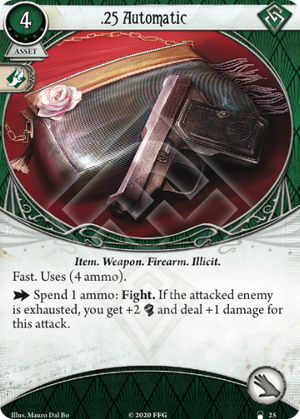As a 4 resource-cost, 4 ammo firearm, the .25 Automatic immediately invites comparisons to its classic big brother in Guardian, the .45 Automatic, and this is a comparison that doesn't do the .25 any obvious favours. In exchange for a single additional point of accuracy on each shot over the .45, the .25 is fast, and green, and... loses both its accuracy and its damage altogether unless the target is exhausted... something that usually takes both an action and a successful test to achieve, and not even the same attribute of test that you need to successfully hit with this gun. This gun in fact does nothing at all unless the target is exhausted!
A fast, do-nothing weapon in Rogue immediately evokes the spectre of level 0 Switchblade, a card with a less than stellar track record for most of the game's history. .25 Automatic then goes on to fail to flatter itself in this comparison, too... at least Switchblade's fast ability meant that it could, potentially, help you in a situation where you could land the over-successful fight check while threatened by an enemy; .25 Automatic's fast ability is useless in this regard, since .25 Automatic will never help you fight unless you successfully evade the enemy first, and if you successfully evade the enemy then (barring weird edge cases where you're engaged with multiple enemies at once) you're at your liberty to play a non-fast weapon without fear of retaliation. Switchblade's other benefit over .25 Automatic was that it provided cheap protection against asset hate, which the Automatic doesn't really do, since 4 resources is a bit too much to pay for good Crypt Chill fodder. You might want level 0 Switchblade in Tony Morgan; you probably don't want this.
So, is .25 Automatic just a bad card that can't compete? I'd argue that it's not. I think it actually serves a niche that has existed in rogue since the game began: it's the gun that can get evasion-capable 3-Fight rogues to the place where they can shoot testing at 5, for 2 damage, without breaking the bank and while leaving them a hand free. Even the upgraded Derringer doesn't quite meet this threshold, since you're really only shooting at 4 in terms of hitting for 2 damage.
Why is testing at 5 with your investigator plus weapon so much better than testing at 4? It's hard to quantify, but from Roland with a .45, to Jenny with her Twin .45s, to Mark with his .32 Colt or Tony Morgan finally making that Switchblade sing, it seems to be something of a golden breakpoint that delineates when a basic weapon and investigator pairing starts to feel good. If you're "Skids" O'Toole, Finn Edwards, Jenny Barnes or Wini Habbamock, then the .25 gets you there, and you should have the evasion chops to make it work. "Skids" will appreciate the fact that it's compatible with his strong parallel card back, and for Finn it looks a lot like extra copies of his Trusty .38, albeit less cost efficient and with a more restrictive use condition.
It's in those two investigators that I feel the .25 Automatic is at its best, since they're likely to appreciate it being fast purely for the sake of saving an action and maintaining strong play speed, and are able to add in the extra evade action to set up their shots without losing undue time. They're also the types who could want to keep a hand free for lockpicks or other investigation assets. The requirement of evading first helps delineate "Skids" gunplay from the hip firing of more dedicated combat characters, and is somewhat reminiscent of machete's "drawback" of getting a guardian to sometimes spend an engage action before attacking - it encourages good practice. Evading enemies is more work, but when an enemy has retaliate or might swing at you for big damage if you miss a shot then needing to evade it beforehand can stop you from getting greedy, and it feeds into a playstyle that could feature cards such as Sneak Attack. It's a silver lining to a fairly demanding play restriction.
In conclusion, don't be put off this weapon by the shadow of its big brother. If you're willing and able to work the evades, this card can be the basic, scenario one weapon you've always needed to leverage a moderately good fight score into a reliable source of two damage hits, and it won't even slow you down during set up.
